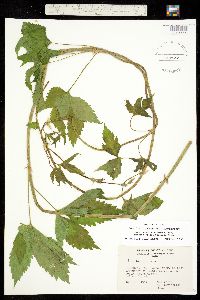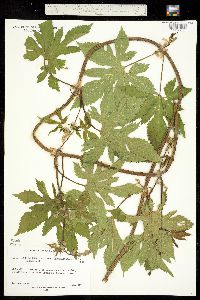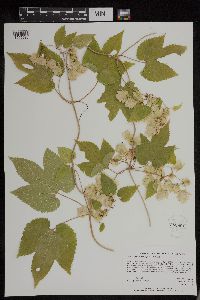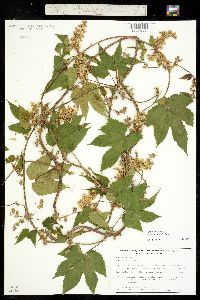Humulus lupulus var. lupuloides
|
|
|
|
Family: Cannabaceae
Common Hop
[Humulus americanus Nutt., moreHumulus lupuloides (E. Small) Tembrock, Humulus lupulus subsp. americanus (Nutt.) A.Löve & D.Löve] |
Stems relatively pubescent at nodes, usually more than 15 hairs per 0.1 sq. mm at most pubescent portion (excluding angle of petiole with stem). Leaf blades 10 cm or more usually having fewer than 5 lobes; smaller blades (ca. 5 cm) often with no more than 3 easily visible veins branching off midrib (excluding proximal branches); surfaces abaxially not conspicuously pubescent, usually fewer than 100 hairs per cm on length of medial midrib, more than 25 glands per 10 sq. mm between veins, hairs usually absent between veins. Moist thickets, woods, riverbanks; 0-2000 m; Alta., Man., N.B., Nfld., N.S., Ont., P.E.I., Que., Sask.; Conn., Del., Ill., Ind., Iowa, Kans., Ky., Maine, Md., Mass., Mich., Minn., Mont., Nebr., N.H., N.J., N.Y., N.Dak., Ohio, Pa., R.I., S.Dak., Vt., Va., W.Va., Wis . Humulus lupulus var. lupuloides , defined as an intermediate, encompasses plants not falling into the other three varieties occurring in North America that are much more distinctive. It intergrades where it is sympatric with the introduced H. lupulus var. lupulus in southern Ontario, southern Quebec, and northeastern United States; with H. lupulus var. pubescens in midwestern United States; and with H. lupulus var. neomexicanus in the southern Canadian prairies and the Dakotas.
Perennial herbaceous vine with rhizomes 1 - 10 m long Stem: twining, branched, relatively hairy at nodes, with rigid, two-branched hairs that help the plant climb. Leaves: opposite, palmately three- to seven-lobed, mostly three-lobed, 3 - 15 cm long, main leaves as wide as long, broadly egg-shaped to more or less heart-shaped with a pointed tip, toothed, usually without hairs between veins beneath, usually fewer than 100 hairs per cm along midrib beneath, yellow-glandular. Flowers: either male or female, borne on separate plants (dioecious), small, without petals. Male flowers whitish to yellowish, with five sepals. Stamens five. Anthers glandular. Female flowers short-stalked, subtended by a leaf-like bract. Ovary covered by the membranous, fused sepals (calyx). Stigmas two, thread-like. Fruit: an achene, enclosed inside the persistent sepals, yellowish, egg-shaped, compressed, glandular, covered by bracts. Male inflorescence: an axillary and terminal, cluster (cymose panicle) of flowers, 5 - 15 cm long. Female inflorescence: an axillary spike of two flowers, 1 - 6 cm long, subtended by a leaf-like bract that is straw-colored, blunt, and glandular at the base. Similar species: The variety pubescens differs by often having unlobed leaves with hairs between the veins beneath. The similar Humulus japonicus differs by having non-glandular, mostly five- to nine-lobed leaves. Flowering: August to mid-September Habitat and ecology: Found on floodplains and in weedy areas under partial shade. Occurence in the Chicago region: native Etymology: Humulus comes from the word humus, meaning ground, referring to the trailing habit of this plant. Lupulus means "little wolf." Author: The Morton Arboretum From Flora of Indiana (1940) by Charles C. Deam Probably found in all or nearly all of the counties of the state. It prefers a moist and sandy soil and is found infrequently in low ground along streams, about lakes, and along roadsides. Our manuals have not separated this from the Eurasian species and all but one of our reports for the wild hop have been made under the name, Humulus lupulus. I doubt that the exotic species is found in Indiana and if so, it is very rare. I have not seen a specimen of it from Indiana. Bailey says: "Lobes of leaves often 5-11," but none of the leaves of my specimens have more than 3 lobes. ...... Indiana Coefficient of Conservatism: C = 5 Wetland Indicator Status: FACU |





























































































